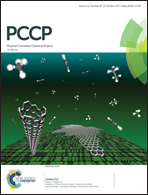On the microscopic origin of the temperature evolution of isosteric heat for methane adsorption on graphite†
Abstract
Understanding methane adsorption is fundamental to understanding gas storage and gas separation technologies. Detailed analyses of methane adsorption on non-porous substrates are pivotal for understanding the intrinsic interactions between the methane molecule and the adsorbent. In this paper, we particularly address the isosteric heat, which is a crucial parameter that characterizes the energetics of such systems. We have used grand canonical Monte Carlo simulations to study methane adsorption on graphite over a range of temperatures (from 50 K to 110 K). Our simulation results show good agreement with experimental data for the 2D phase transition, the 2D triple and critical points in the first layer obtained from low energy electron diffraction, neutron scattering and heat capacity measurements. On the basis of this agreement, we present a detailed microscopic picture of isosteric heat and its evolution with temperature. Our results show that the origin of the cusp and spike in the isosteric heat curve and their shift with temperature are associated with the balance of entropic and enthalpic contributions between the first and second layer.



 Please wait while we load your content...
Please wait while we load your content...